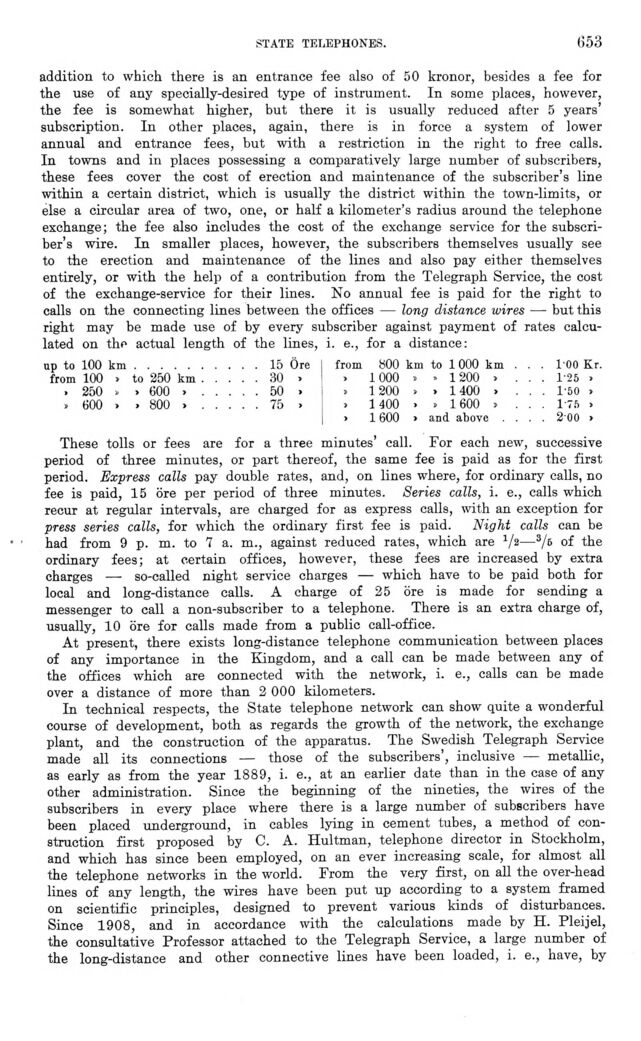
Full resolution (JPEG) - On this page / på denna sida - X. Internal Communications - 6. Telephones. Introd. by E. Halling - State Telephones. By E. Halling

<< prev. page << föreg. sida << >> nästa sida >> next page >>
Below is the raw OCR text
from the above scanned image.
Do you see an error? Proofread the page now!
Här nedan syns maskintolkade texten från faksimilbilden ovan.
Ser du något fel? Korrekturläs sidan nu!
This page has never been proofread. / Denna sida har aldrig korrekturlästs.
STATE TELEPHONES.
(353
addition to which there is an entrance fee also of 50 kronor, besides a fee for
the use of any specially-desired type of instrument. In some places, however,
the fee is somewhat higher, but there it is usually reduced after 5 years’
subscription. In other places, again, there is in force a system of lower
annual and entrance fees, but with a restriction in the right to free calls.
In towns and in places possessing a comparatively large number of subscribers,
these fees cover the cost of erection and maintenance of the subscriber’s line
within a certain district, which is usually the district within the town-limits, or
else a circular area of two, one, or half a kilometer’s radius around the telephone
exchange; the fee also includes the cost of the exchange service for the
subscriber’s wire. In smaller places, however, the subscribers themselves usually see
to the erection and maintenance of the lines and also pay either themselves
entirely, or with the help of a contribution from the Telegraph Service, the cost
of the exchange-service for their lines. No annual fee is paid for the right to
calls on the connecting lines between the offices — long distance wires — but this
right may be made use of by every subscriber against payment of rates
calculated on the actual length of the lines, i. e., for a distance:
up to 100 km..........15 Ore
from 100 j to 250 km.....30 >
. 250 » > 600 >.....50 »
» 600 » » 800 ».....75 >
from 800 km to 1000 km . . . 100 Kr.
1000 > • 1200 » ... 1-25 »
1 200 > > 1400 » ... 1-50 »
1400 > > 1600 > ... 1-75 .
> 1600 > and above .... 2 00 >
These tolls or fees are for a three minutes’ call. For each new, successive
period of three minutes, or part thereof, the same fee is paid as for the first
period. Express calls pay double rates, and, on lines where, for ordinary calls, no
fee is paid, 15 ore per period of three minutes. Series calls, i. e., calls which
recur at regular intervals, are charged for as express calls, with an exception for
press series calls, for which the ordinary first fee is paid. Night calls can be
had from 9 p. m. to 7 a. m., against reduced rates, which are V2—3/5 of the
ordinary fees; at certain offices, however, these fees are increased by extra
charges —- so-called night service charges — which have to be paid both for
local and long-distance calls. A charge of 25 ore is made for sending a
messenger to call a non-subscriber to a telephone. There is an extra charge of,
usually, 10 ore for calls made from a public call-office.
At present, there exists long-distance telephone communication between places
of any importance in the Kingdom, and a call can be made between any of
the offices which are connected with the network, i. e., calls can be made
over a distance of more than 2 000 kilometers.
In technical respects, the State telephone network can show quite a wonderful
course of development, both as regards the growth of the network, the exchange
plant, and the construction of the apparatus. The Swedish Telegraph Service
made all its connections — those of the subscribers’, inclusive — metallic,
as early as from the year 1889, i. e., at an earlier date than in the case of any
other administration. Since the beginning of the nineties, the wires of the
subscribers in every place where there is a large number of subscribers have
been placed underground, in cables lying in cement tubes, a method of
construction first proposed by C. A. Hultman, telephone director in Stockholm,
and which has since been employed, on an ever increasing scale, for almost all
the telephone networks in the world. From the very first, on all the over-head
lines of any length, the wires have been put up according to a system framed
on scientific principles, designed to prevent various kinds of disturbances.
Since 1908, and in accordance with the calculations made by H. Pleijel,
the consultative Professor attached to the Telegraph Service, a large number of
the long-distance and other connective lines have been loaded, i. e., have, by
<< prev. page << föreg. sida << >> nästa sida >> next page >>